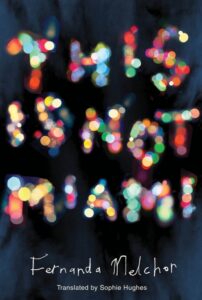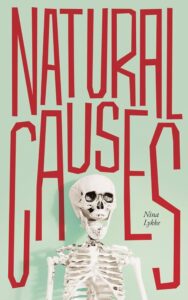Curated by SAM SPRATFORD
This month, our online contributors CHRIS JOHN POOLE, JULES FITZ GERALD, and LAURA NAGLE recommend three inventive, deeply human books with stories that traverse two oceans—from Japan, to Mexico, to Norway.
Fernanda Melchor’s This Is Not Miami (trans. Sophie Hughes); recommended by TC Online Contributor Chris John Poole
In her author’s note to This Is Not Miami, Fernanda Melchor writes that “to live in a city is to live among stories.” The city in question is Veracruz, Melchor’s birthplace, a city of cartel violence and political corruption; ritual magic and cold, hard truth. Veracruz’s stories, meanwhile, are those which are gleaned from—and imposed onto—its grim realities.
The stories in This Is Not Miami are crónicas, a genre with no direct equivalent in the Anglophone canon. Crónicas mix reportage and fiction, in a manner akin to gonzo journalism. They favour subjective accounts and firsthand experience over hard data and rigid chronology. Melchor’s crónicas collate rumours, folk myths, and personal narratives, injecting reportage where necessary.
Over the course of twelve crónicas, Melchor presents vignettes of Veracruz’s recent history. A movie studio buys a decrepit prison from the government; a community demonises the same pageant-queen they once adored; UFO-watchers discover the dark truth behind the lights in the sky. Varied as they may be, these crónicas are soberingly similr: violence, misogyny, and corruption pervade each tale.
The duality of the crónica, blending objectivity and subjectivity, allows Melchor to better explore the interplay between reality and narrative. The stories told in and about Veracruz are attempts to make sense of it: yet they also reshape the city itself. Narrative gives rise to new realities, and vice versa. As Melchor remarks, the root of the word fiction is the Latin fingere, meaning “to shape.” In drawing attention to fiction’s transformative potential, Melchor implies that Veracruz cannot be understood solely on objective terms. Instead, one must examine the stories made of it, and of which it is made. If Melchor’s Veracruz is not Miami, then it is also not, strictly speaking, Veracruz.
This Is Not Miami presents a city which constantly narrates itself: this process reshapes and perpetuates its bitterest realities. Melchor’s crónicas assert that truth and fiction are inextricable, capturing the full force of the stories that Veracruz’s residents create and live among.
Jami Nakamura Lin’s The Night Parade; recommended by TC Online Contributor Jules Fitz Gerald
Jami Nakamura Lin’s debut transcends the genre-boxes in so many delightful ways. On one hand, she has written a deeply personal meta-memoir about her intertwined experiences with bipolar disorder, the death of her father, and the loss of a pregnancy. On the other, she’s written a fascinating ethnographic survey of yōkai, a wide assortment of monsters and mythological creatures from Japanese folklore, thoroughly researched and rigorously footnoted. Lin braids these personal and scholarly strands together to explore how a culture’s storytelling traditions regarding monsters might reflect and potentially reframe attitudes toward mental illness, loss, and grief.
The book uses the macro-form of kishōtenketsu, a conventional Japanese four-part narrative structure influenced by Chinese poetry: ki (introduction), shō (development), ten (twist), and ketsu (conclusion). Within these parts are smaller sections focusing on a different yōkai, such as kitsune, foxlike tricksters who might be gods, and oni-baba, cannibalistic demon-hags. Each section is accompanied by a gorgeous and haunting illustration of these monsters by Lin’s sister Cori Nakamura Lin, which, according to the notes, use their relatives’ faces as inspiration. Thus, “the night parade.”
In her more conventionally memoiristic moments, Lin’s formal innovation extends to her mixed usage of first, second, and third-person perspectives. A parenthetical note invites us in to her reasoning: “(She: a distancing. She: a way to get close. I’ve tried to tell this story so many times, but when I use I—when the girl is me—the story sputters in my mouth….This is what the ghosts know. To get close enough, sometimes you have to pretend you are not you.)” Herexperimental craft elements make this book a must-read for anyone interested in the genre of speculative memoir.
Ultimately, Lin’s book challenges dominant narratives of mental illness, asking, “Are these the only two stories? The one, where you defeat your monster, and the other, where you succumb to it?” The Night Parade offers readers another possibility of learning how to accept and live with bipolar disorder by turning to the stories of the yōkai.
Nina Lykke’s Natural Causes (trans. B. L. Crook); recommended by TC Online Contributor Laura Nagle
When we meet Elin, a middle-aged general practitioner and the narrator of Nina Lykke’s novel Natural Causes, she is exhausted. She has been living for weeks in her office—sleeping on the examination table with her feet in the stirrups, no less—in the wake of an affair that has ended her marriage. She wants to break things off with her affair partner, a guy she dated in her twenties and long referred to as “The Psycho,” but he is texting her night and day. Patients come to her with minor physical ailments and profound existential dread she is unable to mitigate, and in her frustration, she begins lashing out at them. Worst of all, there is only one friend with whom Elin is truly honest, and he isn’t even a person. He’s Tore, the plastic skeleton in the corner of her examining room, and he’s one of the wittiest characters I’ve encountered in a while.
L. Crook’s lively translation from the Norwegian deftly conveys the contradictions in the character and voice of this complex protagonist. Despite her astute observations about the nature of aging and her disillusionment with the upper middle class to which she belongs, Elin cannot acknowledge her own frailties and failings unless she externalizes them in the form of Tore’s wisecracks. By turns exasperating and relatable, Elin is a remarkable creation, and so is the humorous yet thoughtful novel she inhabits.







